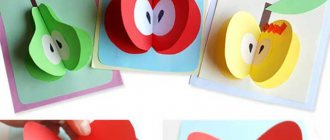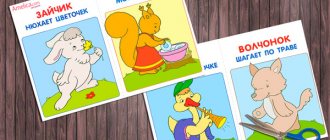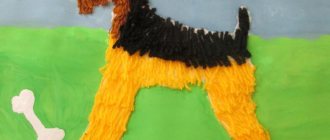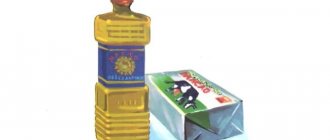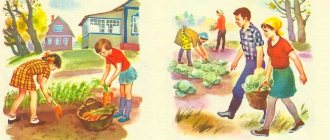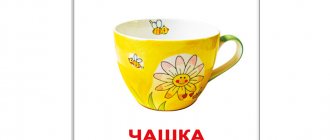Date: March 23, 2022 Author: Irina Gift Category: School
The ability to distinguish good from bad is one of the most important components of interpersonal relationships. After all, the freedom of one person ends where the freedom of another begins. Preschool and primary school age are years of active socialization, when a child learns to interact effectively with other people without violating their personal boundaries. To assess how adequate the child’s ideas about morality are, the method of R. R. Kalinina “Story Pictures” is used.
Methodology “Story Pictures”: author, essence, purpose
The author of the method, Rumiya Rashidovna Kalinina, a candidate of psychological sciences from Pskov, is developing programs to help children with deviations associated with mental reactions to the world around them, and helps in normalizing family relationships. The “Story Pictures” test is used to study children of preschool and primary school age’s understanding of moral standards of behavior. Children 4–5 years old are individually offered pairs of pictures that present scenes illustrating the following concepts:
- generosity and greed;
- responsiveness and indifference;
- friendliness and conflict;
- neatness and untidiness.
For children 6–8 years old, the pair “politeness - inattention” is added. The test takers' task is to classify the images into two piles: positive actions and negative ones.
Without a deep moral feeling, a person can have neither love nor honor - nothing that makes a person a person.
Vissarion Grigorievich Belinsky, literary critic of the 19th century
Without understanding basic norms of behavior, a child will not be able to go through the stage of socialization among peers.
Diagnostic methods for studying the social and communicative development of preschool children
Marina Titova
Diagnostic methods for studying the social and communicative development of preschool children
Section 1 Diagnostic methods for studying awareness of norms and values accepted in society
Name of the technique , author:
Methodology “Unfinished Situations”
(A. M. Shchetinina, L. V. Kirs)
Purpose: to study the characteristics of children’s acceptance and awareness of moral norms.
Diagnostic indicators : awareness of norms and values accepted in society.
Age Range: 3-7 years old
Source of information: child
Form and conditions: individual.
Instructions: The child is told: “I will tell you stories, and you finish them.”
. In each case, you need to get the child to motivate the answer.
Situations:
The children built the city. Olya didn't want to play. She stood nearby and watched others play.
The teacher approached the children and said: “We are going to have dinner now. It's time to put away the toys. Ask Olya to help you." Then Olya answered. What did Olya answer? Why?
2. For Katya’s birthday, her mother gave her a beautiful doll. Katya began to play with her. Then her younger sister Vera came up to her and said: “I also want to play with this doll.”
. Then Katya answered. What did Katya answer? Why?
3. Lyuba and Sasha were drawing. Lyuba drew with a red pencil, and Sasha with a green pencil. Suddenly Lyubin's pencil broke. “Sasha,” said Lyuba, “can I finish the picture with your pencil?” Sasha answered her. What did Sasha answer? Why?
4. Masha and Sveta were putting away the toys. Masha quickly put the cubes in a box. The teacher told her: “Masha, you have done your part of the work. If you want, go play or help Sveta finish cleaning.” Masha answered. What did Masha answer? Why?
5. Petya brought a toy dump truck to kindergarten. All the children wanted to play with this toy. Suddenly Seryozha approached Petya, snatched the car and began to play with it. Then Petya. What did Petya do? Why?
6. Katya and Vera played tag. Katya ran away, and Vera caught up. Suddenly Katya fell. Then Vera. What did Vera do? Why?
7. Tanya and Olya played “mother and daughter”
.A little boy came up to them and asked:
“I want to play too.
We won’t take you, you’re still small,” Olya answered. And Tanya said. What did Tanya say? Why?
8. Kolya played “horses”
.He ran and shouted:
“But, but, but!”
In another room, his mother was putting his little sister Sveta to bed.
The girl couldn’t fall asleep and was crying. Then her mother came up to Kolya and said: “Don’t make noise, please, Sveta just can’t sleep.”
Kolya answered her. What did Kolya answer? Why?
9. Sasha was walking near the house. Suddenly he saw a small kitten, who was trembling from the cold and meowing pitifully. Then Sasha. What did Sasha do? Why?
Processing of results: In the process of analyzing results, the nature of the action and its argumentation are taken into account. Based on the characteristics of the child’s act of the hero of the situation, one can judge the degree of his acceptance of the moral norm, and by the nature of the argumentation of the action, one can judge the awareness of this norm.
High level: the child comes up with an act of the hero that is adequate to the socially accepted ethical norm, and is able to explain this act from the standpoint of the norm.
Average level: the child imagines an action that corresponds to the generally accepted norm, but cannot give reasons for it.
Low level: the child comes up with an ending to a situation in which the hero commits an act that does not meet social moral norms .
Name of the technique . author:
Methodology “
Studying the awareness of moral standards” (G. A. Uruntaeva, Yu. A. Afonkina)
Purpose: determining the level of moral standards in preschool children .
Diagnostic indicators : Awareness of the norms and values accepted in society.
Age Range: 3-7 years old
Source of information: children
Form and conditions: individual
Instructions: The teacher asks the child to complete two tasks with a break of several days: first answer questions about the poems and then finish the stories. The child is asked to answer fully, in detail , in detail.
My friend and I quarreled and sat in the corners.
It's very boring without each other!
We need to make peace.
I didn’t offend her, I just held the teddy bear,
She just ran away with the teddy bear and said: “I won’t give it up.”
.
After reading the poem, children can be asked questions: “Why did the girls quarrel? Which one was to blame? Why? Why did the heroine decide to make peace with her friend? How does she want to do it? Do you have any friends? Name them. Do you quarrel with them or not? Why? If you suddenly quarreled with a friend (girlfriend), then how can you make peace with them?
It is useful to ask the child to come up with an ending to an unfinished story-situation that describes a moral problem situation. For example:
The children played in the sandbox. Masha had two shoulder blades. She was digging with one, and the other was lying nearby. Olya came up and asked: “Masha, please let me play with your shovel, otherwise mine is broken.”
. Then Masha answered... What did Masha answer and why?
Mom was doing the laundry. Vitya was playing: he was building a bridge out of cubes. “Vitya, help me hang up the laundry . I'm very tired"
, said mom. Then Vitya answered... What did Vitya answer and why?
Vova built a tower out of cubes, very tall. Natasha came up to watch him play and accidentally pushed the tower. The cubes fell apart. And then Vova... What did Vova do and why?
Processing the results:
What type of behavior does the child propose, does it correspond to the socially approved model of the described situation?
Does the intended action motivate children and how? If the answer is correct, it refers to:
• the demands of an adult, fulfilling the norm only under his control ( “Mom always says that we need to share”
);
• expected undesirable consequences, trying to avoid public sanctions, measures of influence ( “We must tell the truth, otherwise they will be punished”
,
“I’ll share it with him, otherwise he won’t play with me.”
);
• their utilitarian needs, desires, not understanding the meaning of the social norm, fulfilling it for personal gain ( “I’ll give her a doll, and then she’ll give me something”
);
• the situation described in the story, but does not understand the social content of the norm ( “I gave her a spatula because it was lying nearby”
);
• emotional state, the desire of another, being able to take his position, to understand, but remaining captive of a specific situation ( “You need to help because it hurts”
,
“Give a doll because the girl wants to play”
);
• a moral quality or norm that has become a motive for behavior ( “You can’t be greedy, you have to share”
,
“She will give a doll because she is not greedy”
). Here we can talk about the formation of conscious, and not spontaneous morality, because the child fulfills the social norm because he cannot do otherwise, that is, he proceeds from his inner need.
If the answer is incorrect, it refers to:
- the authority of an adult ( “I didn’t give the doll, my mother won’t let me”
);
— your interests and desires ( “Won’t give you a toy, it’s the only one”
,
"I want to play too"
);
1.3. Name of the technique , author:
Methodology “Finish the story”
(R. R. Kalinina)
Purpose: to study children’s awareness of such moral norms as: kindness - anger; generosity - greed; hard work - laziness; truthfulness - deceit
Diagnostic indicators : Awareness of the norms and values accepted in society.
Age Range: 4-7 years old
Source of information: children
Form and conditions: individual
Instructions: The study is carried out individually. The child is told the following: “I will tell you stories, and you finish them.”
.
After this, four stories are read to the child in turn (in random order)
.
1. The girl’s toys spilled out of her basket onto the road. A boy stood nearby. He approached the girl and said... What did the boy say? Why? How did the boy do? Why?
2. For Katya’s birthday, her mother gave her a beautiful doll. Katya began to play with her. Her younger sister Vera came up to her and said: “I also want to play with this doll.”
. Then Katya answered... What did Katya answer? Why? What did Katya do? Why?
3. The children built the city. Olya didn’t want to play, she stood nearby and watched others play. The teacher approached the children and said: “We’ll have dinner now. It's time to put the cubes in the box. Ask Olya to help you." Then Olya answered... What did Olya answer? Why? What did Olya do? Why?
4. Petya and Vova were playing together and broke a beautiful, expensive toy. Dad came and asked: “Who broke the toy?”
Then Petya answered... What did Petya answer? Why? What did Petya do? Why?
All the child’s answers, preferably verbatim, are recorded in the protocol.
Processing the results. If a child cannot evaluate the actions of children, then this indicates that the concepts of moral norms are not formed.
Low - the child evaluates children’s behavior as positive or negative (right or wrong, good or bad, but does not motivate the assessment and does not formulate a moral standard.
Average - the child names a moral standard, correctly evaluates the behavior of children, but does not motivate his assessment.
High - the child names a moral standard, correctly evaluates the behavior of children and motivates his assessment.
1.4. Name of the technique , author:
Methodology “Story Pictures”
(R. R. Kalinina)
Purpose: to study children’s awareness of such moral norms as: kindness - anger; generosity - greed; hard work - laziness; truthfulness - deceit.
Diagnostic indicators : Awareness of the norms and values accepted in society.
Age Range: 4-7 years old
Source of information: children
Form and conditions: individual
Instructions: The study is carried out individually. The child is told: “Arrange the pictures so that on one side there are those with good deeds on them, and on the other - bad ones. Tell and explain where you will put each picture and why.”
The protocol records the child’s emotional reactions, as well as his explanations (preferably verbatim)
.
Stimulating material application No. 1
Processing of results: The child arranges the pictures incorrectly (in one pile there are pictures depicting both positive and negative actions, emotional reactions are inadequate or absent, interpreted as an unformed concept of moral standards.
Low (2 points)
- the child arranges the pictures correctly, but cannot justify his actions; emotional reactions are inadequate.
Average (3 points)
— by correctly arranging the pictures, the child justifies his actions; emotional reactions are adequate, but weakly expressed.
High (4 points)
— the child justifies his choice
(perhaps names a moral norm)
; emotional reactions are adequate, bright, manifested in facial expressions, active gestures, etc.
It should be borne in mind that not every answer of the subject is evaluated, but his answers as a whole. The age norm is considered to be a score of 3 points, indicating that the child’s emotional reactions are adequate and moral guidelines are sufficiently formed. A score of 2 points is also considered satisfactory. If a child copes with tasks poorly and scores 0–1 points, an individual conversation with a developmental .
Section 2 Diagnostic methods for studying communication and interaction with peers and adults
2.1. Name of the technique , author:
“
Diagnostics of the development of communication with peers” (Orlova I. A., Kholmogorova V. M.)
Purpose: to identify the level of development of communication skills of young children with peers.
Diagnostic indicators : communication activities with peers.
Age Range: 2-4 years old
Source of information: children
Form and conditions: individual
Instructions: diagnostics of communication involves recording the child’s interest in a peer, sensitivity to influences, the child’s initiative in communication, prosocial actions , empathy and means of communication. To determine the level of development of communication with peers, it is proposed to use:
• parameters of communication with peers;
• scales for assessing parameters for the development of communication with peers.
Indicators of children’s communication with peers are the following communication parameters:
— Interest in a peer (does the child pay attention to the peer, examine him, get acquainted with his appearance (comes closer to the peer, examines his clothes, face, figure)
.
— Initiative (the child’s desire to attract the attention of a peer to his actions, eye contact, addressed smiles, demonstration of his capabilities, involvement in joint actions).
— Sensitivity (activity)
- the child’s desire to interact with a peer, the child’s desire to act together, the ability to react to the influences of a peer and respond to them, observation of the actions of a peer, the desire to adapt to them, imitation of the actions of a peer.
- actions (the child’s ability to take into account the wishes of a peer, the ability to share, help, do something together).
- Means of communication (actions through which the child seeks to attract the attention of a peer, involves him in joint actions and participates in them).
The indicators of this parameter are:
Expressive-facial means (emotional coloring of children’s actions, relaxedness of peers)
;
Active speech (pre-speech vocalizations, babbling, individual words, phrases)
.
Processing the results:
Interest in a peer.
points - the child does not look at his peer, does not notice him;
score - the child sometimes glances at a peer, attention is not stable, quickly switches to another subject, does not show interest in the activities of a peer;
point - the child pays attention to his peer, watches his actions with curiosity, but from afar, does not dare to get closer or reduce the distance (passive position)
;
point - the child immediately notices a peer, approaches him, begins to carefully examine, touch, accompanies his actions with vocalizations and speech, does not lose interest in the peer for a long time, and is not distracted.
Carrying out the R.R. test Kalinina among preschoolers and junior schoolchildren
To organize diagnostics, you will need a set of 8 (for children 4–5 years old) or 10 images (for 6–8 year old subjects), as well as a protocol in a form convenient for the experimenter. The testing algorithm is as follows:
- The child receives cards with pictures.
- The organizer defines the task: “Arrange the pictures in two piles so that one contains images of good deeds, and the other contains images of bad actions.”
- The adult also needs to stipulate the following: despite the lack of a time frame, you should not think too long about each card.
- After the baby classifies all the pictures, the adult will need to lay them out again in front of the subject and ask questions: “What is the boy’s mood?”, “Why do you think so?” For children 6 years old and older, only pairs 2, 3, 5 are offered, and the question is: “What do the characters in the pictures feel, do you think?”, “Why?”
The child’s explanations and his emotional reactions should be recorded in the protocol as we work with the images.
File: Stimulus material for diagnostics
A series of pictures for testing
Interpretation of plot pictures.
Seitmuratova A.E.
SDO(O) - 18.
Techniques.
Classifications.
"Classification of objects"
The technique is one of the main ones in psychological examination (Weigl,
1927; L.S. Vygotsky, 1934; Holtstein and Shirer, 1941; B.V. Zeigar
nick, 1970, etc.).
Goal: study of the processes of generalization and abstraction. Based on the experimental material, one can also study the possibility of analyzing the sequence of conclusions, the criticality and deliberation of actions, the characteristics of memory, the volume and stability of attention, and personal reactions.
Material: a set of cards with subject images suggesting categorical classification (toys, clothing, animals, plants, dishes, furniture, tools, transport, etc.).
Instructions: lay out these cards on the table - what goes with what (the names of the groups and their number are not indicated).
Progress of the task:
Stage I – “deaf”: it is proposed to lay out the cards and group them as best as possible. After 16-20 cards have been laid out, stage II of work begins. First, what the child did is assessed. Correctly selected groups are noted (“That’s right, you put the toys together, so you should combine everything: dishes with dishes, clothes with clothes,” etc.). Erroneous decisions are then evaluated and corrected. During stage II, the child is asked questions about the location of the cards and the work is evaluated. It is important to find out the name of each of the identified groups and determine the principle of generalization. This requires verbal explanations from the child. Stage III - it is proposed to connect the selected groups with each other so that the objects of the enlarged group can be given a common name with one (!) common essential feature. Range of application: from 5 to 7 years – stages I, II; from 7 years – III stage of work.
Performance standard: five-year-old children cope with the task in an effective manner, defining the principle of generalization at the functional level. Starting from the age of 6, the norm is to use abstract categories.
Interpretation of plot pictures.
"A series of plot pictures."
Goal: identifying the level of development of visual and logical thinking
The technique is aimed at studying thought processes, intelligence, the ability to analyze the events depicted in the picture (pictures), highlight significant points, the meaning of the situation, draw conclusions, establish spatio-temporal and cause-and-effect relationships. Attention is drawn to the child’s ability to construct a coherent and logically consistent story, and an emotional attitude to the picture(s) is noted. In addition, the types of assistance provided to the child while completing tasks are taken into account. Equipment: plot pictures depicting sequential events.
Instructions for implementation: the pictures are laid out in front of the child in a random order and they are asked to arrange them so as to make a story. “Place the pictures in order and make up a story based on them.” If the child has broken down the series incorrectly, you should try, by asking leading questions, to bring the proposed plot to his understanding. If such help does not lead to success, you can try to start telling; sometimes during the process of telling, the subject finds and corrects mistakes. If the child cannot figure out the sequence of pictures, you should offer him a series of pictures already arranged in the desired sequence. If the child discovers a complete misunderstanding of the plot, after providing him with help, you should stop completing the task.
Analysis of execution results:
4 points - children are able to correctly establish the sequence of events, identify cause-and-effect relationships and compose a story;
3 points - children have difficulty composing a story based on an independently correctly laid out series of sequential pictures, preferring the question-and-answer form. Sometimes they also need help in arranging pictures in the correct sequence;
2 points - children convey the content of a separate plot picture. More often they perceive it in fragments, simply listing the depicted objects and not connecting them with a single plot. Understanding the hidden meaning of plot pictures is difficult. Providing assistance is not effective;
1 point - the child did not understand the meaning of the task.
Processing and interpretation of results
If the child did not cope well with the task, then you should think about contacting a psychologist.
Depending on the quality of the task, the child receives the following grades:
- 0 points - the pictures are arranged incorrectly, the child does not show an emotional reaction to the act depicted or refuses to answer;
- 1 point - the subject distributed the cards correctly, but could not give a rationale for the classification, there are also no emotional manifestations associated with the plot of the drawings, the child is not able to correlate the moods of the people in the illustrations with the situation;
- 2 points - the test taker correctly sorted the pictures and justified his choice, but emotions (despite all adequacy) are expressed very weakly;
- 3 points - the subject correctly laid out the drawings, explained the choice, named the ethical standard and showed adequate intensity of emotional reactions through facial expressions, gestures, and so on.
A score of 3 points is considered the norm. If the child uncertainly evaluates the depicted actions of the heroes and receives 2 points, then to correct the situation, psychologists advise reading more with the child and analyzing the actions of the heroes together with him. This way it will be easier for the little person to learn to evaluate both his own and others’ actions. If a child receives 1 point or even 0, you cannot do without the help of a specialist in developmental psychology.
Testing using the “Story Pictures” method does not require much time, and the result of such a simple diagnosis can be the first sign that the baby has any abnormalities. The technique will allow you to develop a strategy for corrective work with a particular subject in order to help him develop a harmonious personality.
Stimulus material for children of the younger group.The pictures present the following moral standards that are polar in their characteristics.
I. Kindness - greed:
1. the boy treats everyone with sweets from the box, smiles;
2. The girl covers all the toys from the children around her with her hands.
II. Responsiveness - indifference:
1. a little girl is crying, another one is comforting her; the expression on the second girl's face is sympathetic;
2. one boy is crying over a broken car, the other is pointing his finger at him and laughing.
III. Friendliness - conflict:
1. children play together and build a tower of cubes;
2. The boy takes the toy horse from the girl.
IV. Accuracy - inaccuracy:
1. the girl combs her hair in front of the mirror;
2. a girl in a dirty dress, unkempt, tears out pages from a book.
Presentation of tasks for children of the younger group.
Teacher’s instructions: “I will show you different pictures about children. Choose pictures in which children behave well and in which they behave badly.” The pictures are presented to the children in pairs. After the child has laid out the pictures, the teacher lays them all out in front of him again and asks him to show who is happy in the pictures and who is sad.
Stimulus material for children of middle and older groups.
To the four pairs of pictures used to diagnose children of the younger group, a fifth pair is added - politeness - inattention to adults:
1. the child offers the woman a chair, she smiles;
2. Grandmother sits sad, holding her head; the boy plays the drum, laughs.
Presentation of the task for children of the middle and senior groups.
After presenting each pair of pictures, children of senior preschool age are asked the question: “Why do you think so?”
After completing the first task, pictures II, III, V pairs are laid out in front of the child one by one and asked the questions “What is the mood of the people in this picture? How do you think they feel? Why?"
Processing the results.
0 points - the child arranges the pictures incorrectly (in one pile there are pictures with images of both positive and negative actions), emotional reactions are inadequate or absent. In older preschool age, the child incorrectly names the feelings of other people or refuses to answer this question.
1 point - the child arranges the pictures correctly, but cannot justify his actions; emotional manifestations when assessing actions are not expressed. An older preschooler cannot correlate the mood of people in the pictures with a specific situation or explain them.
2 points - by correctly arranging the pictures, the child justifies his actions, emotional reactions are adequate, but weakly expressed. The child correctly names people's feelings, but cannot always explain their reason.
3 points - the child correctly selects children’s actions and justifies his choice. In older preschool age, he names the moral norm; emotional reactions to the actions of the heroes of the situation are adequate and vivid.
For children of senior preschool age, diagnostic data are supplemented with the results of the “Finish the Story” technique.
